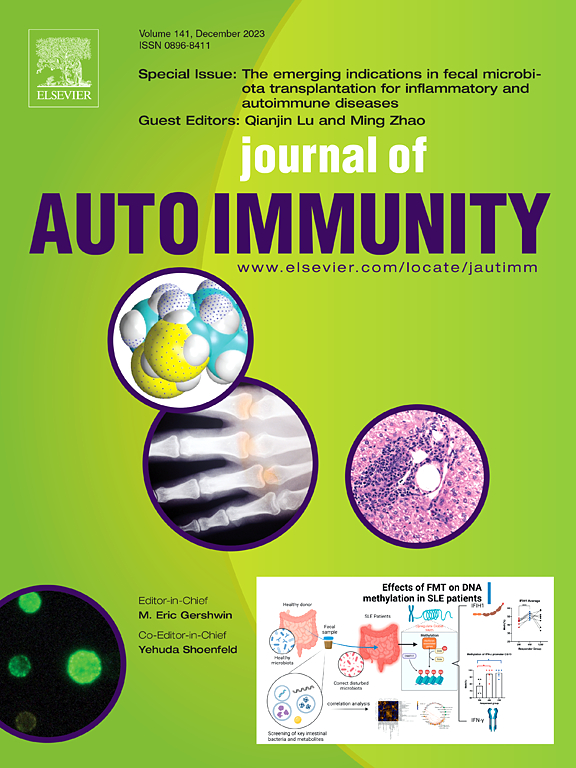Immunobiology of bile and cholangiocytes
IF 7
1区 医学
Q1 IMMUNOLOGY
引用次数: 0
Abstract
The biliary tract is now recognized as an immune organ, and within the biliary tract, both bile and cholangiocytes play a key role in maintaining immune defense and homeostasis. First, immunoreactive proteins such as secretory IgA provide local antimicrobial effects. Second, bile acids (BAs) protect the biliary tree from immune-related injury through receptor signaling, mainly via the membrane-bound receptor TGR5 on cholangiocytes. Third, the biliary microbiota, similar to the intestinal microbiota, contributes to sustaining a stable physiobiological microenvironment. Fourth, cholangiocytes actively modulate the expression/release of adhesion molecules and cytokines/chemokines and are involved in antigen presentation; additionally, cholangiocyte senescence and apoptosis also influence immune responses. Conversely, aberrant bile composition, altered BA profiles, imbalances in the biliary microbiota, and cholangiocyte dysfunction are associated with immune-mediated cholangiopathies, including primary biliary cholangitis, primary sclerosing cholangitis, and biliary atresia. While current therapeutic agents that modulate BA homeostasis and receptor signaling have shown promise in preclinical and clinical studies, future research on biliary/intestinal microbiota and cholangiocyte function should focus on developing novel therapeutic strategies for treating cholangiopathies.
胆汁和胆管细胞的免疫生物学。
胆道现在被认为是一种免疫器官,在胆道内,胆管细胞和胆管细胞在维持免疫防御和体内平衡中起着关键作用。首先,免疫反应蛋白如分泌性IgA提供局部抗菌作用。其次,胆汁酸(BAs)通过受体信号传导保护胆道树免受免疫相关损伤,主要是通过胆管细胞上的膜结合受体TGR5。第三,胆道微生物群与肠道微生物群相似,有助于维持稳定的生理微环境。第四,胆管细胞主动调节粘附分子和细胞因子/趋化因子的表达/释放,参与抗原呈递;此外,胆管细胞衰老和凋亡也影响免疫反应。相反,胆汁成分异常、BA谱改变、胆道微生物群失衡和胆管细胞功能障碍与免疫介导的胆管疾病有关,包括原发性胆道胆管炎、原发性硬化性胆管炎和胆道闭锁。虽然目前调节BA稳态和受体信号的治疗药物在临床前和临床研究中显示出前景,但未来对胆道/肠道微生物群和胆管细胞功能的研究应侧重于开发治疗胆管病变的新治疗策略。
本文章由计算机程序翻译,如有差异,请以英文原文为准。
求助全文
约1分钟内获得全文
求助全文
来源期刊

Journal of autoimmunity
医学-免疫学
CiteScore
27.90
自引率
1.60%
发文量
117
审稿时长
17 days
期刊介绍:
The Journal of Autoimmunity serves as the primary publication for research on various facets of autoimmunity. These include topics such as the mechanism of self-recognition, regulation of autoimmune responses, experimental autoimmune diseases, diagnostic tests for autoantibodies, as well as the epidemiology, pathophysiology, and treatment of autoimmune diseases. While the journal covers a wide range of subjects, it emphasizes papers exploring the genetic, molecular biology, and cellular aspects of the field.
The Journal of Translational Autoimmunity, on the other hand, is a subsidiary journal of the Journal of Autoimmunity. It focuses specifically on translating scientific discoveries in autoimmunity into clinical applications and practical solutions. By highlighting research that bridges the gap between basic science and clinical practice, the Journal of Translational Autoimmunity aims to advance the understanding and treatment of autoimmune diseases.
 求助内容:
求助内容: 应助结果提醒方式:
应助结果提醒方式:


